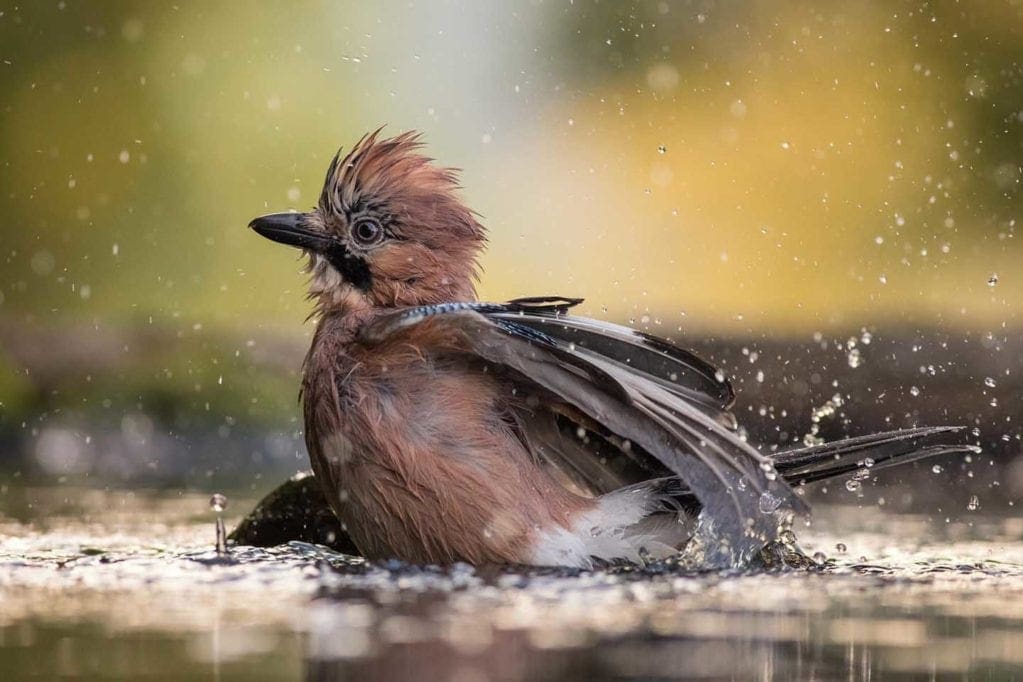Learning how to photograph garden birds might seem like a complex task, but it can be as simple as buying some feed and being patient. And it doesn’t even matter if you don’t have a garden! In this tutorial we’ll explain how to photograph garden birds wherever you may live using a few simple camera settings and techniques.
Because garden birds are prone to sudden, quick movements, the best images are those taken during their momentary periods of calm. To this end you need to encourage them to stop and pause. A great way of doing this is to give them food.
Particularly in the winter and early spring months, birds are scavenging for food and nesting materials, and providing these for them will encourage them to hang around your garden. Setting up a simple perch – it could be a table, chair or even an upturned lid – and covering it with grass, stumps or other natural materials, and placing a food tray on it will encourage birds to land.
Where to photograph garden birds
Depending on the size of your garden and the depth of your patience, you could set up a simple hide – this could even be a small pop-up tent – in your garden not too far away from your perch. From here you can pre-focus on where you think the birds will land and just wait.
If this isn’t practical, you can also photograph garden birds from the comfort of inside your home. Find a seat next to the window facing your perch and, again, pre-focus and wait.
The farther away you are, though, the longer the lens you will need to capture a bird in finer detail.
How to photograph garden birds
01 Set your stage
Think about your image and how it will look. Do you want to set up an obvious table and feeder, or do you want to create a scene that looks more like it’s taken in the wild? If the latter, think about how this should look. Perhaps a log or stump on top of a feed table? There are ways to encourage birds to perch somewhere photogenic.
02 Consider your background
This is important when setting up your perch. The best garden bird photos are those that fill the frame with the subject and place it against a plain background. This emphasises the subject and the details in its feathers.
03 Use a long lens
Depending on whether you’re sat inside, looking out a window, or perched in a hide in your garden, you’ll want to shoot with a long lens. The goal with garden bird photographs is to fill your frame with the subject. To this end, a telephoto lens of around 300mm is ideal.
04 Use manual focus
AF systems have improved so much over the years, and some manufacturers even now offer AF modes designed to track birds. But to photograph garden birds, one of the best techniques is one of the most time-tested.
Set your camera to manual focus and pre-focus on the spot on your perch where you anticipate the birds will land – or the spot where you want them to land. Because eventually they will. Knowing how to photograph garden birds is all about waiting for the perfect moment.
04 Shallow depth of field
You’ll also want to shoot garden birds with a wide aperture in order to achieve a shallow depth of field. This will throw your plain background nicely out of focus, rendering a pleasing wall of colour behind your bird, almost as if you shot it in a studio.
06 Mix it up
When you set up a perch in your garden, the one danger is that all of your images may start to look a bit samey. So, if you can, have a number of perches set up or to hand. Mixing these up will give you a better variety of images.
07 Add some flash
Above we’ve suggested that you can photograph garden birds from a simple makeshift hide, or even from a window inside that faces your garden. But adding some off-camera flash to the mix would enable you to take control of the light and transform flat, overcast light into a more dreamlike setting sun.
Think about the direction you want the light to come from, and place an off-camera flash somewhere off to the side of your perch or feeding table.
Next, mount your camera on a tripod some distance back and pre-focus on your perch. Mount a wireless trigger in your camera’s hotshoe to fire your off-camera flash.
Then you’ll want to trigger your camera remotely using a cabled or wireless remote.

Photo © Szekely Janos 
Photo © Alius Imago 
Photo © Adrian.E.Mortimer. 
Photo © jesslawton 
Photo © Hussain Almubarak 
Photo © Wayne Kliewer 
Photo © Douglas McCall 
Photo © sam 
Photo © VISIONX 
© Dave Wesson













Love this Photography, thanks for this types of special post